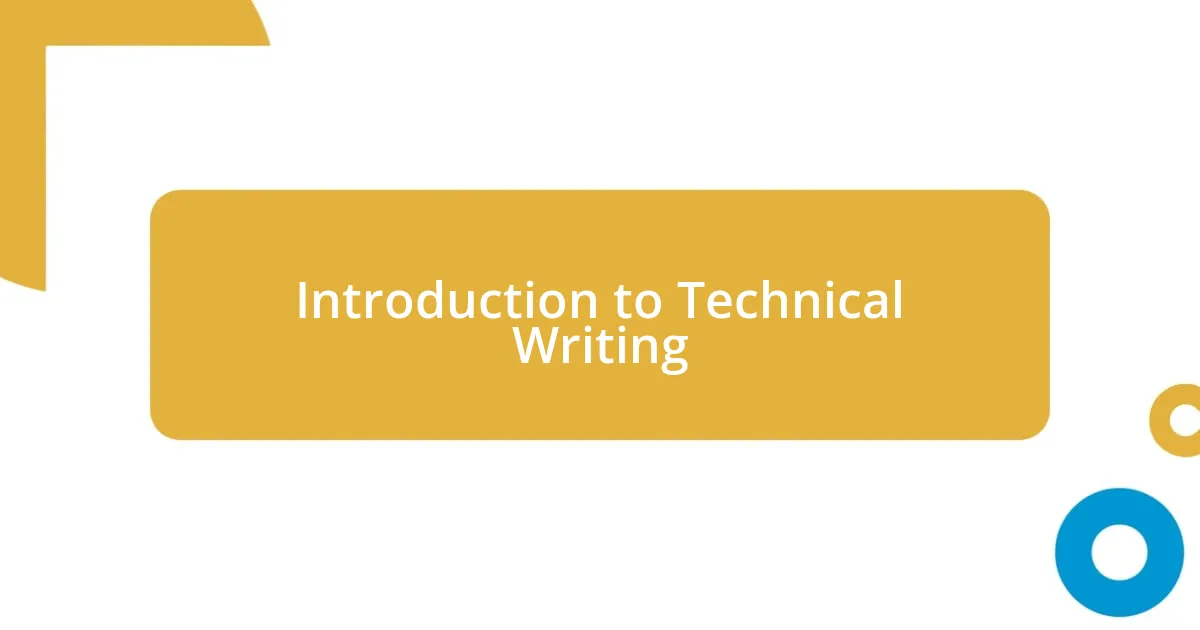Key takeaways:
- Technical writing serves as a bridge between complex information and its audience, emphasizing clarity and engagement.
- Key skills for technical writers include the ability to analyze complex subjects, attention to detail, and effective collaboration with experts.
- Understanding the audience is crucial; tailoring content based on user knowledge levels fosters empathy and enhances communication.
- Continuous improvement through feedback, learning, and setting specific goals is vital for growth in technical writing.

Introduction to Technical Writing
Technical writing is more than just crafting manuals or guides; it’s about clearly conveying complex information in a way that’s accessible and engaging. Early in my career, I remember sitting bewildered over a particularly dense software manual that seemed to speak a language all its own. Have you ever found yourself lost in jargon, wishing someone would just break it down for you? That’s the moment I realized the power and responsibility of a technical writer—to be the bridge between the expert and the audience.
One of the most rewarding aspects of technical writing is the challenge of distilling intricate concepts into bite-sized, understandable pieces. I often reflect on how satisfying it feels when a reader tells me that my documentation made their job easier or helped them understand something they struggled with for ages. Isn’t it incredible to think that your words can genuinely help someone navigate through confusion and uncertainty?
Moreover, technical writing demands adaptability, as the field continuously evolves with technology. I’ve found myself learning new tools and methodologies just to keep up, which can be daunting but also thrilling. How do you stay engaged when things change so rapidly? For me, it’s about embracing that challenge—understanding that every project offers a unique opportunity to grow both my skills and my perspective on effective communication.

Key Skills for Technical Writers
As I reflect on my journey in technical writing, one skill that stands out is the ability to analyze and understand complex subjects. This skill allows me to translate intricate concepts into simpler language, showcasing my commitment to clarity. For instance, I remember tackling a project on cybersecurity protocols, where unraveling the technical jargon took time, but breaking it down helped others grasp vital information—an experience that truly emphasized the importance of this skill.
Another essential skill is attention to detail. In my early projects, I learned that overlooking even a minor detail could lead to confusion or misinterpretation. I vividly recall proofreading a user manual when I discovered that a misplaced comma changed the meaning of a critical instruction. This incident reinforced my belief in the adage, “The devil is in the details,” reminding me that precision can significantly impact the effectiveness of my writing.
Collaboration is also crucial for a technical writer. I’ve often found that working closely with subject matter experts not only enriches my understanding but also fosters a productive relationship that benefits the final product. Engaging in conversations with engineers and developers provides insights that often lead to more accurate and user-friendly documentation. I’ve come to enjoy these teamwork moments where ideas spark and evolve, turning technical discussions into relatable content.
| Key Skills | Description |
|---|---|
| Analysis of Complex Subjects | Translating intricate concepts into simpler language for better understanding. |
| Attention to Detail | Ensuring precision in writing to prevent misinterpretation and confusion. |
| Collaboration | Work with experts to enrich content and improve user experience. |

Understanding Your Audience
Understanding your audience is pivotal in my technical writing journey. There’s something deeply rewarding about knowing you’re crafting content that genuinely resonates with your readers. I vividly recall a project where I had to explain a complex database system. After conducting interviews with end users, I learned they struggled with specific terms that, to me, seemed second nature. It was a moment of clarity—I realized that my role wasn’t just about instructing but also about empathizing with the user experience. This connection fuels my passion for making tech accessible.
Here’s how I approach understanding my audience:
- Identify User Knowledge Levels: I assess whether the audience is made up of novices, intermediates, or experts.
- Gather Feedback: I actively seek input on drafts, asking real users what confuses them.
- Adapt Language and Tone: Depending on the audience, I tailor my writing style to be either more formal or conversational.
- Create User Personas: I develop detailed profiles of ideal readers to guide my writing strategies, ensuring that I meet their specific needs.
Ultimately, every stick of jargon I cut away feels like a way of respecting my readers’ time and intelligence. Connecting with them on this level transforms the technical writing process into a collaborative dance rather than a one-sided lecture.

Structuring Technical Documents
Structuring technical documents is like building a well-designed bridge; the design ensures that information flows smoothly from one point to another. I always start with a clear outline, where main headings represent the bridge pillars and subheadings are the cables that provide support. In one of my earlier projects, I structured a user manual for a software application. The feedback was overwhelmingly positive, as users appreciated how easily they could navigate through sections, find solutions, and understand instructions. It reaffirmed what I already believed—organization is key to clarity.
When it comes to visuals, I find that well-placed diagrams and tables can enhance understanding tremendously. In a recent project tackling a hardware installation guide, I integrated flowcharts to illustrate complex processes. I noticed that users often lingered over the diagrams, pointing out how they could follow the steps visually. This experience highlighted for me how the right structures not only convey information but also promote engagement. Have you ever experienced that ‘aha’ moment when a visual clicked for you? It’s a powerful feeling, and I strive to recreate that for my readers.
Moreover, consistent formatting across documents cannot be understated. I’ve learned the hard way that inconsistent font sizes, heading styles, or color choices can create confusion, detracting from the content’s professionalism. I remember a colleague’s document that jumbled various styles—trying to read it felt like flipping through a funhouse mirror. Now, I make it a point to establish a style guide before I even jump into the writing process. By crafting a coherent visual identity for every document, I ensure that readers can focus on the information rather than becoming distracted by stylistic inconsistencies. After all, a well-structured document is a silent ambassador for clarity and professionalism.

Best Practices for Clarity
When writing for clarity, I find that simplicity is my best friend. I often remind myself that using plain language can bridge the gap between complex concepts and everyday understanding. For instance, in a project where I had to describe cloud storage solutions, I chose to replace technical jargon with relatable analogies—comparing cloud storage to a digital filing cabinet. When I heard feedback about how easily users grasped the concept, it reinforced my belief: clarity shines brightest when we strip away unnecessary complexity.
Another practice I cherish is the art of revising. I recall a time when I crafted a lengthy tutorial filled with detailed instructions. However, after several rounds of editing, I was able to trim it down to a concise yet informative guide. Each revision brought me closer to clarity, making it feel almost like sculpting—removing excess material to reveal the true essence of the message. I imagine many of you have experienced that enlightening moment when you realize that less is genuinely more. Have you ever paused to edit a piece, only to discover the heart of your message shines through once the clutter is gone?
Finally, I cannot emphasize the power of feedback enough. Imagine presenting a project you’re proud of, only to find out it’s too complex for its intended audience. That was me early in my career, and the sting of that realization has stayed with me. Through regular check-ins with colleagues or end-users, I can gauge their understanding and tweak my content accordingly. It’s like having a GPS for your writing—guiding you to the most efficient route to clarity. Engaging others in this process not only helps refine the message but fosters a collaborative spirit that enriches the entire writing journey.

Tools and Resources for Writers
I’ve discovered that the right tools can significantly enhance my writing process. For instance, I rely heavily on software like Grammarly for grammar checks and ProWritingAid for style suggestions. I still recall the early days of drafting documents with only a basic word processor, feeling unsure if my writing flowed well or if I missed glaring errors. Now, with these tools, I feel more confident and supported. How do you ensure your writing is polished before sharing it with others?
Another essential resource I value is a dedicated style guide, like the Microsoft Manual of Style. I firmly believe that having a reference point keeps my writing consistent across projects. When I first started using a style guide, I noticed my efficiency increased; I spent less time second-guessing choices around terminology and formatting. Have you ever suddenly realized that standardization saves you time? It felt like a light bulb moment for me, as I could focus more on content rather than the nitty-gritty details.
Lastly, I’ve benefited greatly from online communities and forums, such as Stack Exchange and specialized writing groups on social media. Interacting with other writers helps me gain fresh perspectives and learn new techniques I hadn’t considered before. I remember a specific instance where someone shared an innovative approach to visual documentation that I adapted for my own project. Have you engaged in a writing community, only to find that the feedback and camaraderie boost your creativity? I find that connecting with others enriches my journey, making me feel supported and inspired in the often-isolated world of writing.

Continuous Improvement in Technical Writing
Continuous improvement in technical writing is a journey rather than a destination. I vividly recall a project where I was assigned to document a complex software system. Initially, I struggled to convey the intricate processes clearly. After reaching out for feedback from my peers and users, I realized my explanations were convoluted. This experience taught me that each interaction, whether it’s a casual chat or a formal review, holds the potential to refine my skills. Have you had that moment when someone’s perspective shifted your entire approach?
As I progressed in my career, I adopted a mindset of lifelong learning. I often delve into webinars and workshops focused on technical writing trends and best practices. One memorable workshop introduced me to the concept of user-centered documentation, which urged me to see my writing through the users’ eyes. It was an eye-opening experience that reshaped my approach, making me more empathetic to the reader’s needs. This new perspective drove me to create content that not only informs but also empowers the reader. Have you ever found that stepping into your audience’s shoes can drastically alter your writing?
Another strategy I embrace is setting specific, achievable goals for improvement. For example, I decided to focus on honing my ability to create visuals that complement my text. After taking a short course on graphic design principles, I started integrating simpler, more impactful images into my documentation. I can still remember the thrill of receiving positive feedback; it was a clear indicator of how effective visuals enhanced understanding. What small yet meaningful improvement have you made that brought about a noticeable change in your writing? Goals like these keep my passion alive and remind me that in the world of technical writing, there’s always room to grow.












